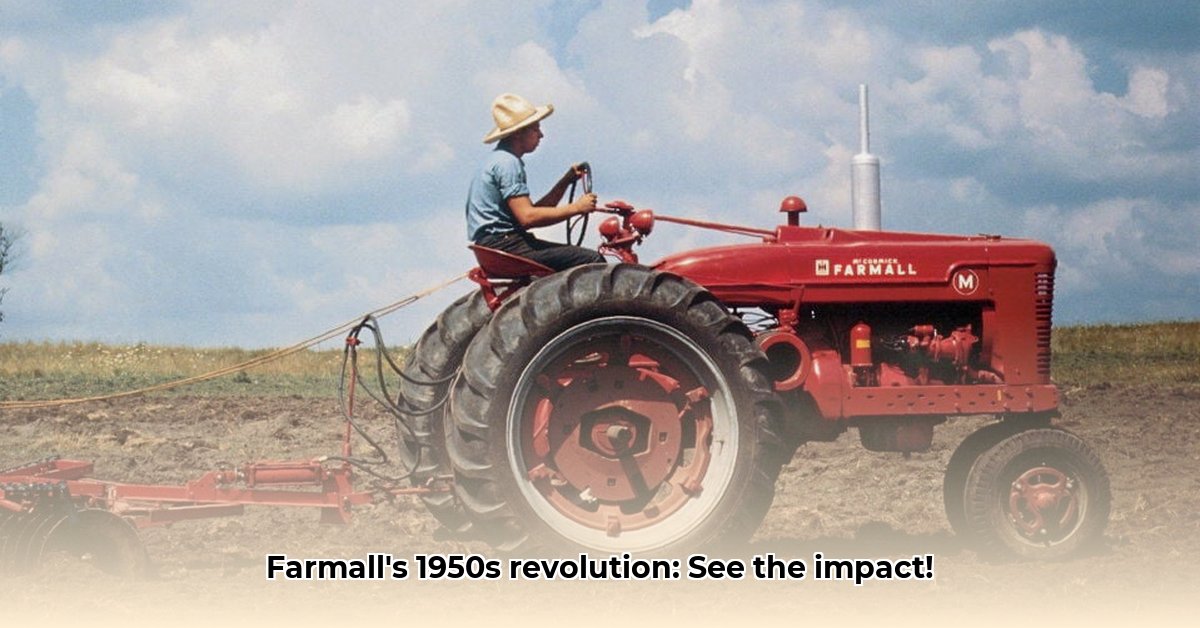
The 1950s witnessed a dramatic transformation in American agriculture, fueled in large part by the innovative Farmall tractors produced by International Harvester (IH). These machines weren't just tools; they were symbols of post-war prosperity and technological advancement, fundamentally changing how farmers worked the land. This article explores the design innovations, market impact, and lasting legacy of Farmall tractors during this pivotal decade. For more on other tractors of the era, see this page on 1950s Oliver tractors.
IH's Engineering Prowess: Beyond Simple Horsepower
International Harvester didn't merely manufacture tractors; they engineered solutions. The introduction of the Touch-Control hydraulic system (a system that uses hydraulic pressure to control the implements) revolutionized tractor operation, making it significantly easier and more intuitive for farmers. Simultaneously, IH focused on improving engine performance, boosting horsepower and fuel efficiency. This directly translated to increased productivity and reduced operating costs, a significant boon for farmers navigating the complexities of post-war agriculture. But how did these advancements translate to the marketplace?
The Competitive Landscape: Farmall's Fight for Market Share
While IH’s Farmall line enjoyed considerable success, the 1950s were far from a monopoly. John Deere, Ford, Allis-Chalmers, and Massey Ferguson were formidable competitors, each vying for a share of a rapidly expanding market. This intense rivalry spurred innovation across the board, resulting in a continuous cycle of improvements in both power and efficiency – a win for farmers and the industry as a whole. The precise market share held by each manufacturer during this period remains a subject of ongoing debate among agricultural historians, with varying figures reported in different historical accounts. However, the Farmall's presence was undeniably substantial, establishing it as a leading brand in American agriculture. Was Farmall truly the number one brand? The available evidence suggests a significant, although not necessarily dominant, market share.
More Than Just Sales: Farmall's Enduring Legacy
The impact of Farmall tractors in the 1950s extends far beyond sales figures. They represent a crucial pivot point in agricultural mechanization, marking a period of rapid technological advancement that forever reshaped farming practices. The robust design and reliable performance of these machines quickly became synonymous with productivity and innovation. This legacy continues to this day, with vintage Farmall tractors highly sought after by collectors and enthusiasts alike. Their enduring appeal speaks to the quality of engineering and the profound impact they had on the agricultural industry.
IH's Diversification Strategy: A Calculated Gamble?
International Harvester's expansion beyond farm equipment, notably into the construction machinery market, remains a subject of historical debate. Some historians suggest this diversification strategy ultimately distracted IH from tractor innovation, potentially hindering its market dominance. Others argue it was a prudent, even essential measure, diversifying revenue streams and bolstering long-term financial stability. The full impact of this strategic shift is difficult to definitively assess, but it serves as a fascinating illustration of the nuanced complexities of corporate decision-making during a period of rapid economic and technological change. Did this diversification help or hinder Farmall's success? This question remains open to interpretation.
Key Players in the 1950s Tractor Market
The following table highlights some of the key players and their significant tractor models during the 1950s:
| Manufacturer | Key Tractor Models (1950s) | Notable Features | Market Impact |
|---|---|---|---|
| International Harvester | Farmall Cub, Super A, MD | User-friendly Touch-Control hydraulics, improved engines | Major market player, setting industry standards |
| John Deere | Model R, 70, 80 | Robust build, known for reliability | Strong competitor, steadily gaining market share |
| Ford | 8N, NAA | Affordable, easy maintenance | Popular choice, especially among smaller farms |
Farmall's Influence on Sustainable Farming Practices
While the environmental impact of farming wasn't as widely considered in the 1950s as it is today, the efficiency gains offered by the Farmall tractors nonetheless contributed to a more sustainable approach to agriculture. Increased efficiency, through the integration of multiple tasks into a single machine, reduced both fuel consumption and labor requirements. This minimized the environmental footprint of farming operations. The incorporation of improved hydraulic systems and the power take-off (PTO) further enhanced efficiency, leading to less land clearing and resource depletion. How did innovations like hydraulics improve resource consumption? They significantly improved the efficiency of machinery, allowing for more work with less fuel.
Key Takeaways:
- Enhanced Efficiency: Farmall's innovative design led to reduced fuel consumption and labor, minimizing the environmental impact.
- Versatile Machinery: The integration of multiple tasks into a single machine reduced the need for specialized equipment.
- Increased Productivity: Higher yields from increased efficiency contributed to food security without requiring large-scale land expansion.
- Technological Influence: Many key design features of 1950s Farmall tractors laid the groundwork for future sustainable agricultural technology.
- Enduring Legacy: The Farmall's contribution to the ongoing pursuit of sustainable agricultural practices ensures its enduring legacy.